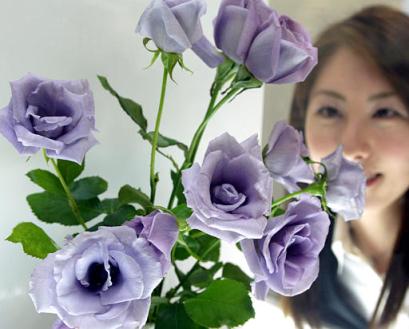|
Human gene may produce blue rose
Roses are red. Violets are blue. Now a gene from a human could turn a rose
blue, too.
Two biochemists researching cancer and Alzheimer's disease drugs at Vanderbilt University made that startling discovery quite by chance — and it could prove to be the grand prize for
rose-lovers yearning to grow naturally blue roses.
Roses occur in many colors in the red-to-yellow end of the spectrum — red
blend, mauve, apricot, pink, white and more — but blue ones do not yet exist in
nature, according to the American Rose Society.
|

|
| Model Aya Kato displays the world's first blue roses at a media preview in Tokyo
Wednesday, June 30, 2004. The blue roses, that had been thought impossible to create for
years, was developed by Suntory and Australian bio venture
FlorigenePty, Ltd., using biotechnology. Blue color pigment extracted from blue flowers was added to roses by recombinant DNA
techniques. (AP Photo/Shizuo Kambayashi) |
In the world of blooms, blue is a particularly difficult hue to achieve because of the complex genetic and environmental cues that lead to its
expression. The blueness seen in flowers like the petunia depend on the synthesis of a pigment called
delphinidin, or 3',5'-hydroxylated anthocyanin. But co-pigments such as flavonol or flavones must also be present to prompt a blue shift in the anthocyanin absorption
spectrum. And the vacuolar pH must be high to produce a true blue
color.
Back in the 1980s, a new breed of horticulturist started to experiment with flower
color. Peter Meyer and colleagues at the Max-Planck Institute in
Cologne, Germany, were the first to apply genetic modification to flower
color.
In 1986, the biotechnology company Florigene was founded in
Melbourne, Australia, to pursue the development of a blue rose, carnation and
chrysanthemums. The three varieties comprise 50% of the world market in cut
flowers. The company isolated two genes necessary for delphinidin production and initiated a program to introduce them into the
flowers. So far, Florigene has developed four varieties of transgenic
"blue" carnation — but even these appear more mauve than truly
blue.
Tim Holton of the Queensland Biotechnology Center in Brisbane,
Australia, led the blue rose project at Florigene for 10 years. He explained
"It was easier to transform the carnation, in part, because we began with a white
flower. The strategy Florigene is using in the rose requires the blue pigments to compete with the natural red
pigments. Suitable white roses did not exist."
Holton further clarified, "Three things are needed to produce a blue
flower: 100% delphinidin production, flavonol and acyl groups." Insertion of the delphinidin synthesis genes can augment production of the appropriate
pigment, but roses lack acyl groups. (Complex acylation pathways are important in producing a blue
petunia.) Roses are also acidic. In the alkaline vacuolar environment of the
petunia, delphinidin is blue; but in the acidic rose vacuole it is
pink. The carnation has a more alkaline vacuolar environment than the
rose.
A third gene involved in delphinidin synthesis in the petunia was identified in 1999. The gene encodes a cytochrome b5 enzyme that enhances the formation of 3',5' substituted
anthocyanins. Petunias in which the gene had been
Peter Guengerich and his colleague Elizabeth Gillam made their accidental finding as they were studying how drugs are metabolized in the
body. They took a gene from a human liver and placed it into
bacteria.
"The bacteria turned blue," said Guengerich, professor of biochemistry and director of the Center in Molecular Toxicology at
Vanderbilt. "That was surprising.
After seeing a flask of bacteria transformed with P450 genes turn
blue, Gillam had a "Eureka" moment. "I had previously read about Florigene and immediately thought this presented an
alternative" to the existing methods of genetically engineering a blue hue into plant
life.
"We knew people have been interested in making a blue rose for years", said
Guengerich, "so we thought if we could move these human genes into
flowers, we might come up with one."
Guengerich and Gillam have filed for a patent for their process, but have encountered some thorns in the
research.
"In our initial attempts, the gene didn't know whether to turn the stem or the thorns or the flower
blue," Guengerich said. "We've seen some of each."
Guengerich said it could be a year or more before a blue bloom
materializes.
"I'm working on other things with the drugs," he said.
"And, it will take some time to work on the blue showing up in the flowers rather than the
stems."
Sam Jones, chairman of this weekend's Nashville Rose Society Spring
Show, was excited by the discovery.
"It's a goal we've been looking for for a long time. And for it to come about from biochemistry rather than plant breeding is very
unique," he said.
"It should be a very popular rose, because blue is often associated with patriotic
themes. You could have red, white and blue bouquets," he said.
"And it's novel, as well."
|
